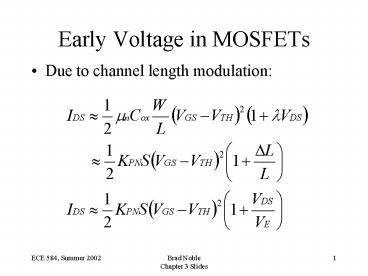Brad Noble - PowerPoint PPT Presentation
1 / 22
Title:
Brad Noble
Description:
What really happens if VGS VTN? In digital design, IDS = 0. ... Note: This is not really true due to recombination, but its close! ECE 584, Summer 2002 ... – PowerPoint PPT presentation
Number of Views:69
Avg rating:3.0/5.0
Title: Brad Noble
1
Early Voltage in MOSFETs
- Due to channel length modulation
2
Saturation Voltage
- Vpinchoff VDS,sat VGS VTH
- Separates resistive from saturation region
- The drain current is given by
- Solving for VDS,sat
- Good to solve for quiescent voltage-current.
3
Ex Find VDS,sat for an NFET
4
Variations in VTH Across Channel
- We assume VTH is constant across channel
- THIS IS NOT TRUE!
- Depletion region is thick at S and thin at D.
5
Notes on PFETs
- PFETs typically have a shape factor 3 or 4 times
larger than NFETs - Body effect can be eliminated in PFETs by tying
the n-well to VDD - Need 6?m spacing between n-wells to isolate.
- Dr. Engel always does this on input devices, not
always elsewhere.
6
Weak Inversion
- What really happens if VGS lt VTN?
- In digital design, IDS 0.
- We call it weak inversion or W.I.
- IDS is primarily due to Idrift in strong
inversion and Idiffusion in weak inversion.
7
Modes of Inversion
- IDS Idrift Idiffusion
- If VGS gt VTN the channel has been inverted.
- To be more precise, we can say the channel has
been strongly inverted (S.I.) due to an
abundance of carriers in the channel. - Inversion is independent of whether the FET is in
the linear or saturation region.
8
Weak Inversion Idiffusion
- Drain is more reverse biased than source
- To find Idiff, compute gradient
- Because no carriers are lost as they travel from
S to D, current is the same for all x and
gradient is not a function of x. - Note This is not really true due to
recombination, but its close!
9
W.I. Surface Potential
10
Deriving Weak Inversion IDS
11
W.I. FET As Exp. Law Dev.
- S must be big for device to be useful.
- If VDS 100mV, can be neglected.
- For W.I. vDS,Sat ? 100mV
- Looks like a BJT
12
Inversion Coefficient
- Let
- Shape factor as a function of ?
- Lets you chose shape to match inversion mode.
13
Ex. Using Inversion Coeff.
14
Small Signal Analysis
15
Ex Quiescent Point
Question How many digits are significant?
16
Small Signal Model Limits
- Suppose the previous circuit is the input device
of an amplifier. - Small-signal model holds as long as the
deviations are small
17
Taylor Series Expansion
- Taking a Taylor expansion of one variable
18
Small Signal Model Params
19
Example Small Signal Analysis
20
Small Signal Low-Freq Model
21
Ex Find gm and rO
22
Transconductance W.I. M.I.
- What is gm for a weakly inverted FET?
- What is gm for a moderately inverted FET?
Not in textbooks!































